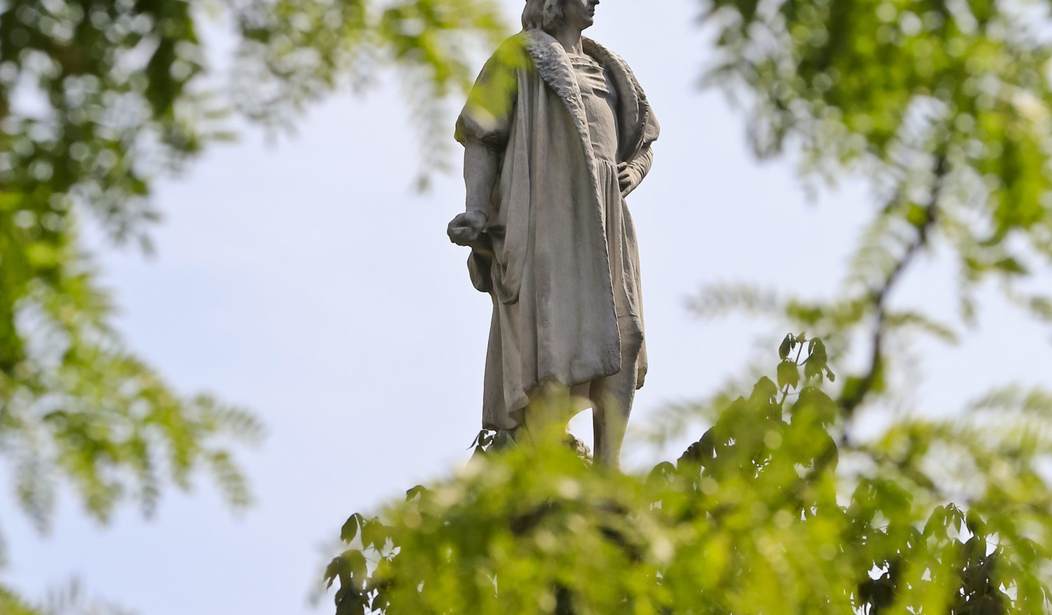After the death of George Floyd, Black Lives Matter protests across America devolved into riots. Rioters vandalized public spaces with graffiti and knocked over statues. It began with Confederate monuments, but vandals progressed to targeting America’s heroes, such as George Washington, Thomas Jefferson, and Abraham Lincoln. Then came Mahatma Gandhi, Union General Ulysses S. Grant, black Union soldiers, and freed slave Frederick Douglass. Vandals even attacked a monument to 9/11 firefighters and painted a statue of Jesus black.
Some of these acts of vandalism might have been mistakes, but the attacks on Christopher Columbus seem intentional. Many proponents of Marxist Critical Race Theory blame Christopher Columbus for the defeat and “genocide” of native Americans. Cities across America have caved to the Columbus hate and decided to remove statues of the Italian explorer from their public squares.
As BLM activists toppled statues of Robert E. Lee and George Washington, they carved out some time to vandalize Columbus, too. Rioters toppled a statue in St. Paul, Minn. After rioters removed a statue in Richmond, Va., they carried the statue 200 yards, set it on fire, and cast it into a lake. Another band of vandals removed a Columbus statue’s head in Boston.
In July, a horde of antifa rioters converged on the Columbus statue in Chicago, Ill. They came armed with sharpened umbrellas, frozen water bottles, and fireworks. They proceeded to besiege police who defended the statue in a scene reminiscent of Greek hoplite warfare. The siege left forty-nine officers injured. Mayor Lori Lightfoot (D-Chicago) honored the brave cops by caving to antifa agitators and ordering the statue removed.
As Columbus Day approached, other mayors across America followed Lightfoot’s cowardly example. On Friday, Pittsburgh Mayor Bill Pueto ordered the removal of the Columbus statue in Schenley Park. On the same day, the mayor of Syracuse, N.Y., also ordered a Columbus statue’s removal. Early last week, leaders of the Italian American Alliance in Boston, Mass., said they were surprised to hear the Columbus statue in Boston would not be returned after the statue was beheaded in June.
Louisville Cancels King Beheaded in the French Revolution as Rioters Give Us a Taste of the Terror
Before these most recent announcements, CBS News reported that no fewer than 33 statues of Christopher Columbus have been taken down since June.
Cities are caving right and left because the radical Left has dominated much of the commanding heights of American culture, and Marxist critical race theorists have demonized Columbus.
“For Native people in the U.S., Columbus Day represents a celebration of genocide and dispossession,” Megan Hill, a citizen of the Oneida Nation of Wisconsin and a program director at the Harvard Project on American Indian Economic Development, wrote in The Harvard Gazette.
“The irony is that Columbus didn’t discover anything,” Hill argued. “Not only was he lost, thinking he had landed in India, but there is significant evidence of trans-oceanic contact prior to 1492. The day celebrates a fictionalized and sanitized version of colonialism, whitewashing generations of brutality that many Europeans brought to these shores.”
This anti-Columbus view is tragically mainstream. While Christopher Columbus was not the first European to discover America, his voyages corrected Europeans’ misconceptions about the world and connected Europe, Asia, and Africa with the Americas. Tragically, this enabled grave injustices like slavery and racial stratification. Yet the pre-Columbian states in North and South America had their own injustices, as well, and neither Hernan Cortes nor Francisco Pizarro could have succeeded in defeating the Mexica (Aztec) and Incan Empires without the help of other native Americans whom those empires had previously oppressed.
Accusations of genocide are rarely backed up by evidence. Europeans did often subject native Americans to forms of slavery and oppression, but the major killer of native American populations was disease — diseases that the Europeans unwittingly carried with them. Occasionally, the Europeans used the disease as a weapon (smallpox blankets), but for the most part, the tragic and horrific collapse of native American populations had more to do with unwitting transmission of disease than with intentional slaughter.
Why Is Joe Biden Silent on the Attacks Against Catholic Statues, Churches, and Beliefs?
The Columbian exchange
Columbus enabled the European conquest of the Americans, but he also initiated the “Columbian Exchange,” linking parts of the world in a trade network that made people in every corner of the globe richer. Crops that had previously only grown in the Americas became available in Europe, Asia, and Africa, while Europeans introduced livestock, writing systems, and new crops like coffee and sugar to the Americas.
Before Columbus, potatoes, corn, tomatoes, and tobacco only grew in the Americas. Potatoes helped Europeans stave off hunger, and they also spread as far as India. In the 1500s, Spanish colonizers introduced corn and sweet potatoes to Asia, resulting in population growth. Pizza was not invented until the 1800s!
Europeans also introduced many new crops to the Americas, including almonds, bananas, carrots, cinnamon, citrus, coffee, garlic, oats, olives, peach, peaches, pistachios, and wheat. Some of these crops helped natives fend off food scarcity and starvation. Livestock like cattle, pigs, sheep, and horses were also introduced, allowing for a more meat-heavy diet.
While writing developed independently in Mesoamerica, the grand Inca Empire of Peru and many other Native American tribes did not have written languages. The Europeans exploited this weakness, but they also introduced writing to these unlettered people.
Europeans also introduced new technologies like the compass, the navigational map, and new forms of crop rotation. The merging of the two worlds had negative consequences, but it also brought long-term benefits that people around the world now enjoy.
The Real Tragedy of Removing Chicago’s Columbus Statue
Columbus Day is a multicultural holiday
Finally, celebrations of Christopher Columbus have a noble history in America.
Much of the demonization of Columbus traces back to an anti-Catholic anti-Italian prejudice that led the Ku Klux Klan and other groups to demonize the Italian explorer. The celebration of Columbus Day actually helped American diversity, integrating this Italian-American hero into America’s pantheon and encouraging acceptance of Italian-Americans (who were not considered “white” at the time).
“Columbus has been a target of white supremacists since the 1920s, when a resurgent Ku Klux Klan attacked monuments and celebrations of Columbus from coast to coast,” Patrick Korten, a member of the National Christopher Columbus Association (NCCA) board of directors, said in 2017.
“They hated that he was Mediterranean, not Anglo, that he sailed for Spain, not England, that he was popular in the immigrant community, and most of all, that he was Catholic,” Korten added, noting that “Catholics, along with African Americans and Jews, were regular targets of the Klan.”
The NCCA board member warned that “the disparagement of Columbus today has its roots in a centuries-old habit of painting Italian and Hispanic immigrants in this country as cruel, violent, sexually aggressive and untrustworthy. In the context of Spanish exploration, this is known as the ‘Black Legend’ — based on propaganda peddled about Spain dating from the 16th century, which continues to be the grist for racially tinged comments about Hispanics and Italians to this day.”
One of the catalysts for Columbus Day came on March 14, 1891, when an angry New Orleans mob lynched 11 Italian immigrants after they were cleared of murder charges.
Columbus Day helped Americans recognize Italian immigrants as their fellow Americans — with a noble heritage.
Christopher Columbus and the day on which Americans celebrate him are not symbols of oppression, but symbols of American pluralism, the acceptance of a new influx of Americans from Columbus’ native Italy. Just as the 13th Amendment corrected a historic American evil by abolishing slavery, so this holiday helped combat the anti-Italian prejudice behind a horrific lynching.
Tragically, Black Lives Matter and antifa agitators seem intent on demonizing and erasing this legacy along with so much of America’s noble heritage. Mayors should not cave to this pressure.
Tyler O’Neil is the author of Making Hate Pay: The Corruption of the Southern Poverty Law Center. Follow him on Twitter at @Tyler2ONeil.









Join the conversation as a VIP Member